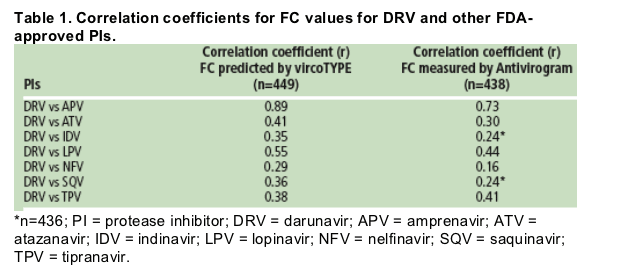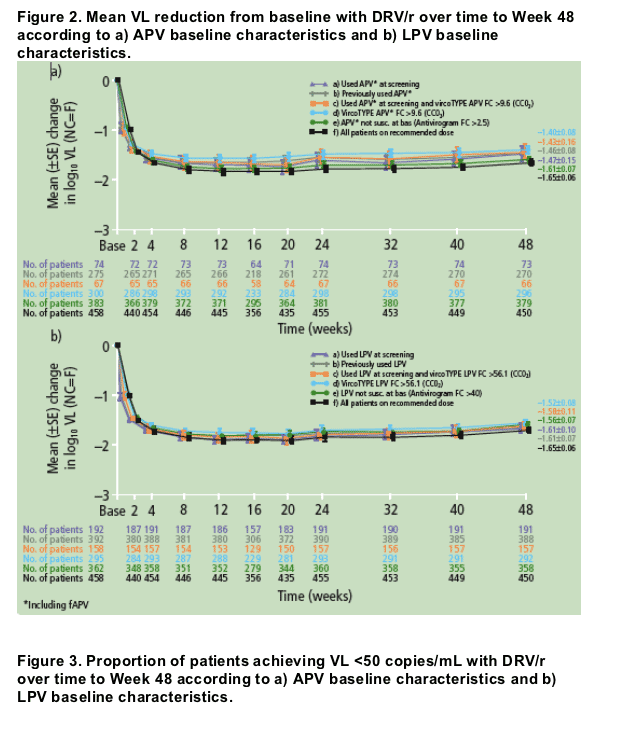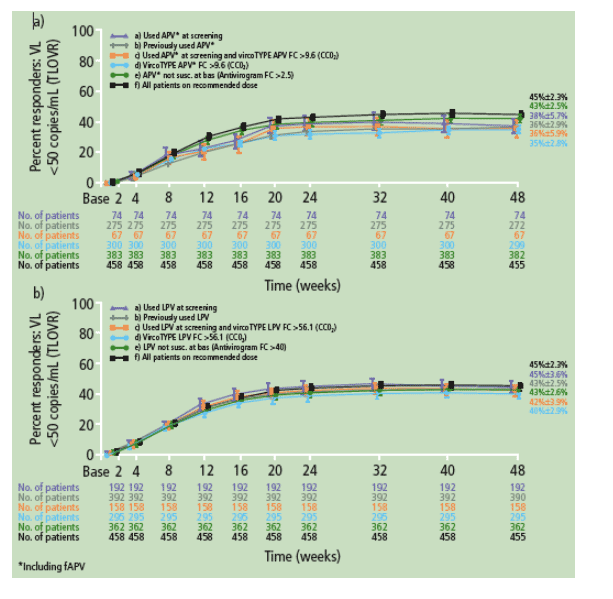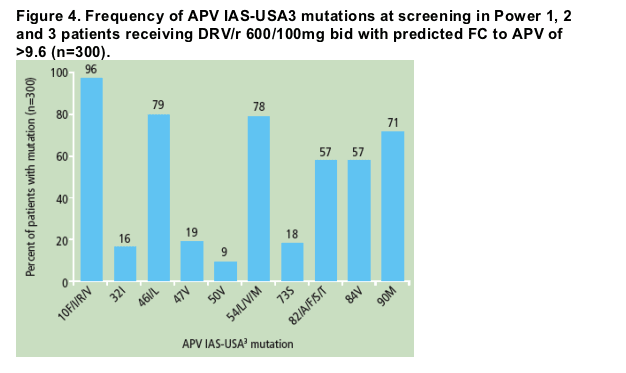 |
 |
 |
| |
Prior utilization/resistance to amprenavir at screening has minimal impact on the 48-week response to darunavir/r in the POWER 1, 2 and 3 studies
|
| |
| |
Reported by Jules Levin
CROI, Feb 2007, Los Angeles
Gaston Picchio,*1 Tony Vangeneugden,2 Ben Van Baelen,2 Eric Lefebvre,1 Diego Miralles,2 and Marie Pierre de Bethune2
1Tibotec, Inc., Yardley, PA, USA; 2Tibotec BVBA, Mechelen, Belgium
"....The protease inhibitors (PIs), amprenavir (APV) and darunavir (DRV; TMC114), share some common genetic determinants of decreased susceptibility. Thus, it is possible that prior exposure to APV or fosamprenavir (fAPV) could influence the virologic response to DRV/low-dose ritonavir (DRV/r)-containing regimens...... Based on this stringent analysis, high levels of resistance to, and use of, APV or fAPV at screening seemed to have only a minimal impact on the virologic response to DRV/r 600/100mg bid at 48 weeks in patients enrolled in POWER 1, 2 and 3. These findings reinforce the concept that DRV retains activity against isolates resistant to APV..... A high level of correlation in phenotypic susceptibility among all the PIs studied was observed between DRV and APV, however, for any given level of APV phenotypic susceptibility, DRV on average exhibited lower FC values than those for APV; this result further illustrates the high genetic barrier exhibited by DRV...."
ABSTRACT
Background: The protease inhibitors (PIs), amprenavir (APV) and darunavir (DRV; TMC114), share some common genetic determinants of decreased susceptibility. Thus, it is possible that prior exposure to APV or fosamprenavir (fAPV) could influence the virologic response to DRV/low-dose ritonavir (DRV/r)-containing regimens. Virologic response was investigated in patients enrolled in the POWER 1, 2, and 3 studies receiving the recommended DRV/r dose (600/100mg bid), who at screening were failing an APV- or fAPV-containing regimen and/or had unequivocal evidence of APV resistance.
Methods: We evaluated the mean (±SE) log10 viral load (VL) reduction (non-completer = failure [NC=F]) and proportion of patients (±SE) achieving VL <50 copies/mL (time to loss of virologic response [TLOVR]) at 48 weeks in POWER 1, 2 and 3 according to the following criteria at screening: a) use of APV or fAPV as part of the failing regimen, b) any previous use of APV or fAPV, c) use of APV or fAPV as part of the failing regimen and having a predicted fold-change (FC) in EC50 to APV of >9.6 (clinical cut-off 2 (CCO2) for APV vircoTYPE version 4.0.01 assay), d) having a predicted FC to APV of >9.6, e) having a measured FC to APV >2.5 (biological cut-off [BCO] for APV Antivirogram assay), f) all patients irrespective of prior use/susceptibility to APV. Predicted FC values were determined with the virtual phenotype linear model (vircoTYPE) while measured ones were with the Antivirogram assay. In addition, we determined the correlation coefficient (r) values between baseline FC (n=455) to DRV and all approved PIs.
Results: The highest r value between FC values was observed for DRV and APV (0.89), followed by DRV and lopinavir (LPV; 0.55), DRV and atazanavir (ATV; 0.41), DRV and tipranavir (TPV; 0.38), DRV and saquinavir (SQV; 0.36), DRV and indinavir (IDV; 0.35) and DRV and nelfinavir (NFV; 0.29).
The mean VL reduction among the subgroups was: a) -1.47 ± 0.15 log10 (n=73), b) -1.46 ± 0.08 log10 (n=270), c) -1.43 ± 0.16 log10 (n=66), d) -1.40 ± 0.08 log10 (n=296), e) -1.61 ± 0.07 log10 (n=379) and f) -1.65 ± 0.06 log10 (n=450).
For the same subgroups, the proportion achieving VL <50 copies/mL was: a) 38% ± 5.7% (n=74), b) 36% ± 2.9% (n=272), c) 36% ± 5.9% (n=67), d) 35% ± 2.8% (n=299), e) 43% ± 2.5% (n=382) and f) 45% ± 2.3% (n=455).
The median number (inter-quartile range) of APV IAS-USA mutations in subgroups a) and c) were 4 (4-5) and 5 (4-5), respectively.
Conclusions: Based on this stringent analysis, high levels of resistance to, and use of, APV or fAPV at screening seemed to have only a minimal impact on the virologic response to DRV/r 600/100mg bid at 48 weeks in patients enrolled in POWER 1, 2 and 3. These findings reinforce the concept that DRV retains activity against isolates resistant to APV.
Author Conclusions:
A high level of correlation in phenotypic susceptibility among all the PIs studied was observed between DRV and APV
- however, for any given level of APV phenotypic susceptibility, DRV on average exhibited lower FC values than those for APV; this result further illustrates the high genetic barrier exhibited by DRV.
The above findings may explain why high levels of resistance and/or prior use of APV or fAPV had only a minimal impact on the virologic response to DRV/r 600/100mg bid in patients enrolled in POWER 1, 2 and 3.
No impact on the responses observed with DRV/r was demonstrated as a consequence of prior use and/or resistance at baseline to LPV, a PI exhibiting a lower correlation coefficient in FC values with DRV.
Clinical outcomes similar to those observed in patients failing to respond to, or with resistance to other PIs, can be expected in patients with previous failure or resistance to APV- or fAPVcontaining regimens receiving DRV/r 600/100mg bid.
Introduction
The structurally-related PIs, APV and DRV, share some common genetic determinants of decreased susceptibility.1 Thus, it is possible that prior exposure and/or resistance at baseline to APV or fAPV could influence the virologic response to DRV/r-containing antiretroviral regimens.
Patients from POWER 1, 2, and 3 who received DRV/r 600/100mg bid, the recommended dose for treatment-experienced patients, and who were failing to respond to an APV- or fAPV-containing regimen at screening and/or had unequivocal evidence of resistance to this PI at baseline were assessed for virologic response to DRV/r.
Methods
Predicted and measured FC in EC50 values at baseline to all currently approved PIs were determined with the virtual phenotype linear-model method (vircoTYPE version 4.0.01, Virco BVBA, Belgium) and the Antivirogram assay (Virco), respectively
- information was available for 449 patients using the virtual phenotype assay and for 436-438 patients using the Antivirogram assay
- the vircoTYPE assay used APV CCOs for both APV and fAPV, as those specifically for fAPV were not available at the time of analysis.
The relationship between DRV and each approved PI in phenotypic susceptibility was studied using piecewise linear regression (DRV vs APV) or linear regression analysis (DRV vs all remaining Pls).
In addition, we determined the mean (±SE) log10 viral load (VL; HIV-1 RNA) reduction (NC=F) and proportion of patients (±SE) achieving VL <50 copies/mL (TLOVR) at 48 weeks in the POWER 1, 2 and 3 studies according to the following criteria at screening or baseline.
a) use of APV or fAPV or LPV as part of the failing regimen
b) any previous use of APV or fAPV or LPV
c) use of APV or fAPV or LPV as part of the failing regimen and having a predicted FC to APV or fAPV >9.6 or to LPV >56.1 (CCO2 for APV/r and LPV/r, respectively; vircoTYPE version 4.0.01)
d) having a predicted FC to APV >9.6 or to LPV >56.1 (CCO2)
e) having a measured FC to APV >2.5 (BCO) or to LPV >40 (BCO and CCO2) for APV and LPV/r, respectively (Antivirogram)
f) all patients irrespective of prior use/susceptibility to APV or fAPV or LPV.
Results
The highest correlation was observed between DRV and APV, followed by DRV and LPV; these findings occurred irrespective of which type of phenotype test was used (Table 1).

Scatter plots were then constructed to study the relationship between the predicted FC to DRV and to APV (Figure 1a), and between the predicted FC to DRV and to LPV (Figure 1b), in terms of virologic response at Week 48.

CCOs (vircoTYPE v 4.0.01) for DRV/r, APV/r and LPV/r, are represented by solid blue horizontal and vertical lines. The Antivirogram low CCO for DRV (CCO1=10.0)2 is shown as reference (dotted white horizontal line). The proportion of samples in each susceptibility quadrant is shown in blue. The purple lines represents the bisector.
Virologic response (VL reduction from baseline and proportion of patients with VL <50 copies/mL) was analyzed for patients receiving DRV/r 600/100mg bid by different APV and LPV baseline characteristics (Figures 2 and 3). Observed efficacy as a function of prior APV or fAPV use was not different relative to the overall efficacy for all patients on the recommended dose.


Many of the patients in POWER 1, 2 and 3 were resistant to APV or fAPV at screening (Figure 4). The median number of APV IAS-USA mutations3 for patients who were receiving APV at baseline as part of their failing regimen and for those who also had a predicted FC to APV >9.6 (CCO2) were 4 and 5, respectively.

References
1. Johnson VA, et al. Update of the drug resistance mutations in HIV-1: Fall 2006. Top HIV Med. 2006 Aug-Sep;14(3):125-30.
2. De Meyer, et al. Phenotypic and genotypic determinants of resistance to TMC114: pooled analysis of POWER 1, 2 and 3. Presented at the XV International HIV Drug Resistance Workshop. 13-17 June 2006; Sitges, Spain. Poster number 73.
3. Johnson VA, et al. Update of the drug resistance mutations in HIV-1: Fall 2005. Top HIV Med. 2005 Oct-Nov; 13(4):125-31.
|
| |
|
 |
 |
|
|